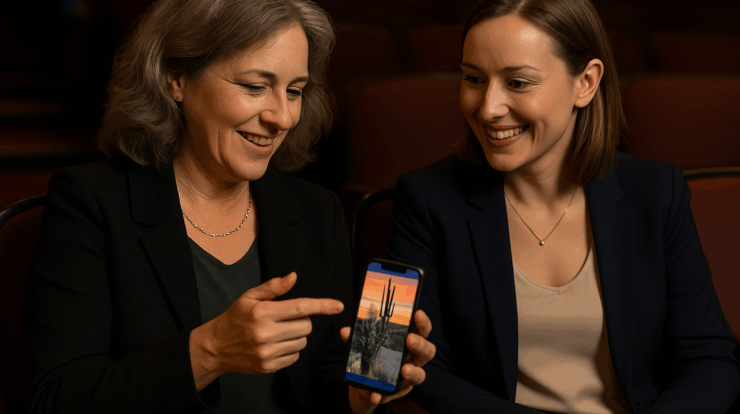
Most artists freeze when someone asks, “What kind of art do you make?” It’s such a simple question, but it feels loaded—like every word has to prove your worth as a creative. So you ramble. You hedge. You describe your medium, your themes, your inspiration—and by the end, the listener has politely nodded but stopped listening.
We talked in a recent article about building conversational confidence through small, low-stakes interactions. Once you’re comfortable starting those conversations, the next step is knowing how to describe your art clearly and memorably. That’s where your two-sentence pitch comes in.
Here’s the key: stop trying to explain everything. Instead, aim for two or three sentences that invite curiosity. Think of it as a spark, not a summary.
Distill to Two Sentences That Invite a Follow-Up
Your goal isn’t to tell your whole story—it’s to start a conversation. The best short pitches make the listener want to ask questions.
One artist I know describes her work this way: “I paint the spaces between order and chaos. My landscapes start as precise geometry and end up a little wild.”
That’s it. Two lines. But almost everyone who hears it asks, “What do you mean by that?” or “Can I see an example?” That’s the point—it opens a door instead of closing it.
When your pitch ends with an image, an emotion, or a contrast, people naturally want to know more.
Write Weekly About Your Work to Find the Language
Finding that perfect phrasing doesn’t happen in a single sitting. It’s a process of writing, testing, and refining. I often encourage artists to spend a few minutes each week writing about their art—not just describing it, but exploring what drives them, what’s changing in their studio, and what they notice in the world that connects to their work.
Patterns will start to emerge. Certain words will feel like “you.” Others will feel forced. Over time, your short pitch will rise naturally out of that writing. It’s less about marketing copy and more about finding your authentic shorthand.
Keep It Intriguing, Specific, and Repeatable
Vague statements fall flat. “I paint from nature” doesn’t go anywhere. But “I paint the quiet moments in nature that most people miss” creates an image. “I’m exploring how light behaves in water” tells me exactly what to look for when I see your work.
Your words should stick in your mouth easily—short enough to repeat in conversation, distinct enough to be remembered.
To illustrate, here are two examples of how Xanadu Gallery artists might apply this principle in their own ways:

Title: Gigantic (detail)
Medium: Mixed Media
Dimensions: 72″h x 30″w
If Dave Newman, known for his nostalgic mixed-media collages built from fragments of Americana, were to use this approach, he might say:
“I build visual time capsules from the fragments of American life—license plates, postcards, and weathered signs become pieces of memory in my mixed-media collages. My work celebrates the nostalgia of the open road and the stories etched into the landscapes of the Southwest.”

Title: Sonoran Sunrise
Medium: Oil
Dimensions: 48″h x 36″w
And if John Horejs, celebrated for his serene oil landscapes of the American West, were refining his own concise introduction, he might say:
“I paint the quiet poetry of the Western landscape—places where light, color, and form come together in simple harmony. My work invites a moment of stillness, a sense of calm that collectors often say brings peace into their homes.”
Sound Spontaneous, Even If It’s Practiced
Yes, you’ll practice this line over and over. That’s fine. Every gallerist, actor, and entrepreneur does the same. The key is to deliver it like you just thought of it.
It helps to rotate between two or three versions, depending on the audience. You’ll sound fresher, and you’ll learn which phrasing draws the best reaction.
Less Pressure, More Connection
When you stop trying to cram your whole artistic journey into a single answer, you free yourself to be present. The listener’s curiosity becomes part of the rhythm.
You don’t need a paragraph—you need a spark. A two-sentence pitch isn’t just a summary of your art. It’s an invitation to a longer, more meaningful exchange.
